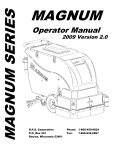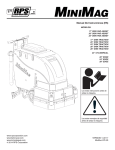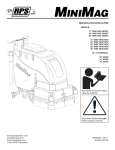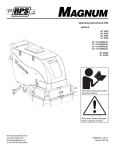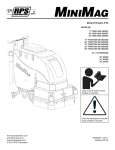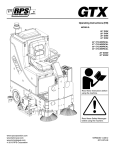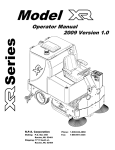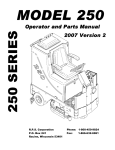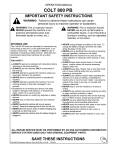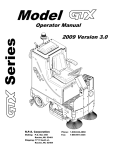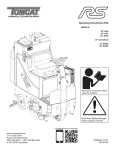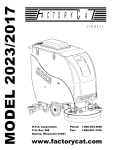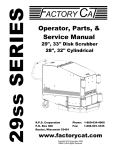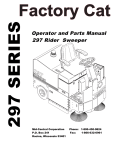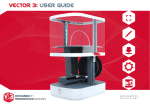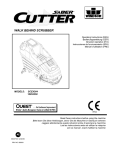Download Mini Mag Operator Manual .dft - Refurbished Floor Cleaning
Transcript
MINI-MAG Operator Manual 2009 Version 2.0 R.P.S. Corporation P.O. Box 241 Racine, Wisconsin 53401 Phone: 1-800-450-9824 Fax: 1-866-632-6961 HOW TO USE THIS MANUAL This manual contains the following sections: - HOW TO USE THIS MANUAL - SAFETY - OPERATIONS - MAINTENANCE - PARTS LIST The SAFETY section contains important information regarding hazard or unsafe practices of the machine. Levels of hazards are identified that could result in product or personal injury, or severe injury resulting in death. The HOW TO USE THIS MANUAL section will tell you how to find important information for ordering the correct replacement parts. The OPERATIONS section is to familiarize the operator with the operation and function of the machine. Parts may be ordered from authorized dealers. When placing an order for parts, the machine model and serial number are important. The MAINTENANCE section contains preventative maintenance to keep the machine and its components in good working condition. They are listed in this general order: Refer to MACHINE INFORMATION on page one of this manual, which is filled out during the installation of your machine. - Batteries - Scrub Brushes - Adjusting Squeegee - Service Schedule - Machine Trouble Shooting The serial number of your machine is located on the lower half of the control panel of the machine. (See Picture Below) The PARTS LIST section contains assembled parts illustrations and corresponding parts list. The parts lists include a number of columns of information: Serial Number * - ITEM - Column refers to the reference - PART NO. - Column lists the part number - QTY - Column lists the quantity of the part - DESCRIPTION - Column is a brief description - COMMENTS - Column for information not number on the parts illustration. for the part. used in that area of the machine. of the part. noted by the other columns. NOTE: If a service or option kit is installed on your machine, be sure to keep the KIT INSTRUCTIONS which came with the kit. It contains replacement part numbers needed for ordering future parts. As our policy is one of constant improvement, all information and specifications are subject to change without notice. * STANDARD WARRANTY POLICY (RPS Corporation) RPS Corporation warrants its machines, parts and accessories to be free of manufacturer’s defects for the periods specified below. Warranty will be granted at the sole discretion of RPS Corporation and is subject to final claim and parts review by R.P.S. Corporation and its vendors. This policy is effective January 1, 2010 and is subject to change on production units at a future date. COVERAGE, EXCLUSIONS AND LIMITATIONS: Coverage: All Models sold (Sweepers, Scrubbers, Burnishers) Parts: 36 months / 1,500 hours on “Power On” hour meter Labor: 12 months Travel: 3 months (150 mile maximum) Poly Tanks: 7 Years OEM Parts: 3 months Validity: Fully completed Machine Delivery Form (online or fax) is on record at RPS. Limitation: Warranty will begin on date of machine installation to end-user or 6 months after shipment from RPS Corp to the distributor if unsold at that time. This warranty includes all parts on the machine except normal wear parts. Some of these exceptions are: 1. Any Brooms, Brushes, Pads or Pad Drivers including Center Clip Retainers 2. Floor Seals, Wipers, Splash Curtains, Squeegees or Gaskets. 3. Filters, Dust Collection Bags or Screens 4. The safety pins design to fail in shear, which are a fail-safe device 5. Belts, Hoses or Tubing. 6. Caster Wheels, Tires or internal tire tubes. 7. Vacuum motors with evidence of water/foam passage or more than 450 hours 8. Lights (Strobe, Headlights or bulbs). 9. The Batteries (see below). NOT COVERED: Routine maintenance, adjustments or parts damaged from abuse, neglect, improper use of the machine, or lack of scheduled “daily, weekly, monthly” maintenance in accordance with our published PM Sheets. POLY TANKS: 7 Years Coverage against leakage due to manufacturer’s defect in materials or workmanship. NOTE: Freight coverage for 3-Years under the parts section of warranty. BATTERIES: Warranted through battery manufacturer for One (1) Year (prorated) from the date of delivery. The battery manufacturer approves or denies the warranty coverage after analysis. We rely on solely on their review. NOTE NOT COVERED: Damage from lack of water, failure to use OEM charger, or non-distilled water. TABLE OF CONTENTS MACHINE INFORMATION FORM WARRANTY REGISTRATION FORM MACHINE SPECIFICATIONS COMMON WEAR PARTS SAFETY MESSAGES !!SAFETY PRECAUTIONS!! MACHINE CONTROLS AND FEATURES MACHINE SETUP ADJUSTING & REMOVING SQUEEGEE INSTALLING PAD DRIVER OR BRUSH INSTALLING CYLINDRICAL BRUSHES MACHINE OPERATION ADJUST SOLUTION FLOW & CURTAINS, DRAINING TANKS CLEANING RECOVERY TANK TIP TANK, RAISE & LOWER SQUEEGEE ADJ. DECK HEIGHT, VAC MOTOR & SOLUTION FILTER CHARGING BATTERIES ON-BOARD BATTERY CHARGER "OPTIONAL" MAINTENANCE & STORING MACHINE PREVENTATIVE MAINTENANCE RECORDS LCD SCREEN MENU DISPLAY'S TROUBLESHOOTING PAGE 1 PAGE 2 PAGE 3 PAGE 4 PAGE 5 PAGE 6 PAGE 7-8 PAGE 9 PAGE 10 PAGE 11 PAGE 12 PAGE 13-15 PAGE 16 PAGE 17 PAGE 18 PAGE 19 PAGE 20 PAGE 21-24 PAGE 25 PAGE 26-27 PAGE 28 PAGE 29-32 MACHINE INFORMATION Please fill this area out at the time of installation for future reference. Model Number_____________________________________________________________ Serial Number:______________________________________________________________ Installation Date:___________________________________________________________ Installing Dealer:__________________________________________________________ Dealer Contact: ___________________________________________________________ Address:____________________________________________________________________ City, State, Zip: ______________________________________________________________ Phone Number:_____________________________________________________________ This operator and parts manual should be considered a permanent part of the unit and should remain with the unit at all times. This operator and parts manual covers all the Mini-Mag series scrubbers. You may find descriptions and features that are not on your particular model. The information and specifications included in this publication were in effect at the time of printing. R.P.S. Corp. reserves the right to make changes without notice or incurring any obligation. To register for warranty, fax your warranty registration form today! FAX # (886)-632-6961 PAGE 1 R.P.S. CORPORATION P.O. BOX 241 RACINE, WI 53401 PHONE: 800-450-9824 FAX 866-632-6961 MACHINE DELIVERY FORM Dealer: __________________________ Installed By: ______________________ Location: (City, State)_______________ Install Date: ______________________ Customer Information Name:________________________ Contact: _________________________ Address:_________________________ City/State:__________________Zip______ Phone Number :___________________ Fax Number: _____________________ Model Number:___________ Serial Number:______________ Squeegee Size:__________ Squeegee Material: Gum Linatex Hour Meter:____________ Neoprene (circle one) Buyer’s representative has received instruction in proper operation of the following controls and features: Filling Solution Tank, Solution Tank Sight Tube, Solution Drain Valve Adjusting Controls and “Uni-Touch” operation, Double Scrubbing, Squeegee Delay & Vac Timer Recovery Tank Draining and Cleaning, Vac Screen Removal and Cleaning Shroud and Pad Removal Shroud Adjustment Solution Valve and Filter Operation (removal and cleaning) Drain Saver Feature Charging Operation Seat and Steering Wheel Adjustment LCD Screen Display Operation, 3 Hour Meters (keyswitch, brush, traction drive) Tank Tilt Back Feature Parking Brake Override Checking Battery Electrolyte Level Squeegee Hose Removal and Checking For Clogs Battery Guide Poster Hung Up & Reviewed Maintenance Guide Poster Hung Up & Reviewed In addition to the items listed above the buyers representative has received the operator’s manual and been advised to read the manual before operating the machine. Installed By (print)______________________Signature________________ Buyer’s Representative (print)_____________________Signature_______________ BUYER AGREES TO PAY FOR ANY REPAIRS, ADJUSTMENTS, OR SECONDARY TRAINING THAT MANUFACTURER DETERMINES IS EXCLUDED FROM THE WARRANTY COMPLETE AND FAX FORM to 866-632-6961 PAGE 2 MACHINE SPECIFICATIONS MINI BODY / DIMENSIONS Tank Material: Chassis Construction: Front Wheels: Rear Casters: Size (L x W x H): Weight (w/batteries) BRUSHSYSTEM Disk Brush/Pad Size: (Brush Drive) MINIMAG Poly (3/8” thick) 1/8” Coated Steel (2) 9” x 2” (2) 4” x 2” 45” x 18” x 40” 374 lbs Poly (3/8” thick) 1/8” Coated Steel (2) 9” x 3” (2) 4” x 2” 48” x 18” x 40” 387 lbs 17-BD: (1) 17” 20-BD: (1) 20” 23-BD: (1) 23” Disk Brush Motor (Single Disk): Disk Brush Motor (Twin Disk 26”): Cylindrical Brush Size: Cylindrical Brush Motor: Brush Down Pressure: 0 – 125 pounds 17-TD: (1) 17” 20-TD: (1) 20” 23-TD: (1) 23” 26-TD: (2) 13” (1) 1.0 hp / 200 rpm (2) 0.75 hp / 270 rpm 24-FC (2) 22”” (2) 0.75 hp / 350 rpm 0 - 150 pounds BATTERY SYSTEM: System Voltage Standard Battery Rating: Optional Battery Rating: Battery Run Time: Charger (110-v / 60 Hz / 24-volt): 24 volts 115 ah 165 ah Up to 3.5 hours Onboard / Automatic 24 volts 115 ah 165 ah Up to 3.5 hours Onboard / Automatic DRIVE SYSTEM Standard Drive: Forward Speed: Reverse Speed: Brush Drive 0-230 ft/min (4 mph) 0-130 ft/min (2 mph) 0.5 hp, all gear / sealed 0-230 ft/min (4 mph) 0-130 ft/min (2 mph) SOLUTION SYSTEM: Solution Tank Cap.: Solution Flow Rate: Solution Filter: 17 gallons 0 - 1.0 gpm Stainless / Inline 17 gallons 0 - 1.0 gpm Stainless / Inline RECOVERY SYSTEM: Recovery Tank Cap.: Vac. Power: Drain Hose: Vacuum Specs (lift / airflow): Demisting Chamber: Drain Saver: 17 gallons 0.75 hp 1.5” diameter 68” / 70 cfm 1.25 gallons 30 cubic inches 17 gallons 0.75 hp 1.5” diameter 68” / 70 cfm 1.25 gallons 30 cubic inches GENERAL: Cleaning Width: Cleaning Rate/Hour (Sq.Ft/Hr): Sound Level: (1) 1.0 hp / 200 rpm (Traction) 17-BD: 17” 20-BD: 20” 23-BD: 23” 17-TD: 17” 20-TD: 20” 23-TD: 23” 26-TD: 26” 24-TC: 24” Up to 22,124 Up to 25,543 70 dBA @ Operator’s Position for all units RPS CORPORATION P.O. Box 368 Racine, WI 53401 Phone: (800) 634-4060 Fax: (866) 901-3335 www.factorycat.com www.tomcatequip.com AUTHORIZED DISTRIBUTOR Copyright RPS Corporation 2006. All right reserved. Since our policy is one of constant improvement, all specifications are subject to change without notice. PAGE 3 COMMON WEAR PARTS BRUSH P/N F OR BRUSH P/N F OR MACHIN ES WITH SERIAL #50000 MACHIN ES PRIOR TO SERIAL #50000 & GREATER REF: CYL DOOR REF: CYL DOOR ASSEMBLY ASSEMBLY BRUSHES MODEL MODEL MODEL MODEL MODEL MODEL 17"-DISK 20"-DISK 23"-DISK 26"-DISK 24"-CYL 24"-CYL SUPER-GRIT TOUGH-GRIT MIDI-GRIT LIGHT-GRIT POLY (.028) NYLON (.016) TAMPICO PAD DRIVER DIAMOND DRIVER 17-421SS 17-421S 17-421C 17-421PS 17-421P 17-421N 17-421T 17-421D 17-421DD 20-421SS 20-421S 20-421C 20-421PS 20-421P 20-421N 20-421T 20-421D 20-421DD 23-421SS 23-421S 23-421C 23-421PS 23-421P 23-421N 23-421T 23-421D N/A 13-421SS 13-421S 13-421C 13-421PS 13-421P 13-421N 13-421T 13-421D N/A NEW STYLE N/A 225-821S 225-821C 225-821PS N/A 225-821N N/A N/A N/A OLD STYLE N/A 22-521S 22-521C 22-521PS N/A 22-521N 22-521T N/A N/A NOTE: # In Disk Column Denotes Pad Size: 13,17, 20, 23 PADS SUPER BLACK BLACK BROWN GREEN BLUE RED WHITE DISK ##422BB ##422B ##422BR ##422G ##422BL ##422R ##422W LEVEL VERY HIGH HIGH HIGH MEDIUM MODERATE MODERATE LIGHT COLOR BLACK BLACK BROWN GREEN BLUE RED WHITE EXTRA PAD DRIVER RETAINING CLIP: 40-433 BRUSH REPAIR KIT: 40-423 REPLACEMENT LOCATING CLIP FOR ALL DISK BRUSHES. SQUEEGEE SIZE'S 32" SQUEEGEE "STANDARD" ON ALL MACHINES. 35" SQUEEGEE "OPTIONAL" Note: Squeegee Assemblies (complete) listed below all come with Linatex blades. SIZE 32" 35" Kit Includes: P/N 23-7180 25-7180 GUM RUBBER 22-770G 25-770G LINATEX 22-770L 25-770L SOAP Heavy Duty Degreaser Citrus Freezer Tire Mark Remover For more soap information call PowerCat 414-745-9337 www.powercatsolutions.com (1) Rear Blade, (1) Front Blade, and (2) Backup Wheels with hardware. Note: Size is stamped into the top of the painted steel squeegee blank on 32", 35" squeegees. Note: The Squeegee is designed for narrow isles and may not have the same water control around tight turns as the larger squeegees. PAGE 4 SAFETY MESSAGES Your safety, and the safety of others, is very important, and operating this unit safely is an important responsibility. To help you make informed decisions about safety, we have provided operating procedures and other safety information in the manual. This information informs you of potential hazards that could hurt you or others. It is not practical or possible to warn you of all the hazards associated with operating this unit. You must use your own good judgment. This machine is intended for commercial use. It is designed to be used on hard floors in an indoor environment, with the recommended pads or brushes. 1. DO NOT OPERATE UNIT: Unless trained and authorized. Unless operator manual is read and understood. If unit is not in proper operating condition. 2. WHEN OPERATING UNIT: Remove loose objects from the floor that may be projected from the revolving brushes. Keep hands and feet away from revolving brushes. Do not operate machine where flammable liquids are present. Use extreme caution when maneuvering. 3. BEFORE LEAVING: Drain Tanks Make sure machine is turned off. Stop on level surfaces. Disconnect batteries. 4. BEFORE SERVICING: Stop on level surface, and secure machine. Disconnect batteries. PAGE 5 !! SAFETY PRECAUTIONS!! WARNING: Always use the charger provided by WARNING: Hazardous voltage. Shock, burns or fire can result. Keep sparks and open flames away. the maufacturer to charge the machine. It is an automatic charger, specifically designed to charge at the appropriate rate. If you must use a different charger, disconnect the batteries before charging. This will prevent damage to the electronic speed controller. WARNING: Charge unit in a well ventilated area, and WARNING: Understand the dynamic braking electrocution can result. Always disconnect the batteries before servicing machine. WARNING: Batteries emit hydrogen gases. Explosion or keep battery compartment open when charging. Explosion or fire could result. WARNING: Battery acid can cause burns. Wear system before you operate the machine on ramps. Machine may coast. WARNING: Do not park the machine on ramps protective eye wear and gloves when servicing batteries. or slopes. WARNING: Do not store outdoors or pressure wash. Prevent electronic components from getting wet. WARNING: The use of parts and solutions other than that recommended by the manufacturer may cause damage or endanger people. WARNING: Dress safely. Do not wear rings or metal wrist watches while working on this machine. They can cause an electrical short, which, can cause serious burns. Do not work on this machine while wearing a tie, scarf or other loose, dangling neckware or clothing. These loose items can tangle in the rotating parts and cause serious injury or even death. WARNING: Do not operate the machine if any parts have been removed or damaged. WARNING: Do not remove, paint over, or destroy warning decals. If warning decals become damaged, they must be replaced. WARNING: Do not operate machine in unsafe condition. If the machine is in need of repair or is in any way unsafe to operate, the matter should be reported immediately to the shift supervisor. Do not operate the machine until it is returned to proper operating condition. WARNING: This machine must only be WARNING: Do not use the machine as a step ladder or chair. WARNING: Only operate this machine from the operators position. It was not designed to carry passengers. operated by trained operator. As part of his or her training, they must read this manual thoroughly. If extra copies are needed, contact your local dealer. WARNING: Always turn off the machine, before leaving it unattended. WARNING: Do not operate this machine on ramps or uneven surfaces. When climbing a ramp, always drive the machine in forward straight up or down the ramp. Never drive across the incline. Do not back down or turn on ramps! PAGE 6 WARNING: Do not operate over electrical floor outlets. May result in serious injury. MACHINE CONTROLS AND FEATURES 3 2 4 15 5 16 17 18 14 13 1 12 22 19 20 6 20 6 7 21 10 8 9 11 21 10 11 22 25 24 23 26 27 37 28 36 29 35 44 34 30 38 45 39 40 31 32 41 33 26 PAGE 7 42 43 CONTROLS AND FUNCTIONS 1. MAIN POWER SWITCH: Turns the machine on and off. 2. BATTERY GUAGE/HOUR METER: Indicates the amount of battery charge remaining. 3. SCRUBDECK DOWN PRESSURE GUAGE: Indicates the amount of down pressure being applied to scrubdeck. 4. SOLUTION FLOW SWITCH: Turns solution flow on. 5. SCRUBDECK SWITCH: Raises and lowers the scrubdeck and controls amount of down pressure being applied. 6. KEY SWITCH: Turns power on to the machine. (Standard on Traction Drive, Optional on Brush Drive.) 7. CIRCUIT BREAKER: 2 AMP resettable circuit breaker. 8. CIRCUIT BREAKER: 25 AMP resettable circuit breaker. 9. CIRCUIT BREAKER: 40 AMP resettable circuit breaker. 10. SPRAY JET (BLUE) (OPTIONAL): Activates Spray Pump for remote Spray Wand. 11. CHARGER PORT: Red 50 used to receive charger input for optional external charger. 12. HANDLE BAR: Adjustable Handle Bar 13. REVERSE SWITCH: Pull back for reverse. 14. SOLUTION FLOW CONTROL KNOB: Turn clock-wise to reduce, counter-clockwise to increase solution flow. 15. LCD SCREEN: Lists functions and settings of the machine. 16. MENU CONTROL: Scrolls through different options on the LCD display, there are three different screens. 17. SCRUBDECK SWITCH: Raises and lowers the scrubdeck. 18. DOWN PRESSURE TOGGLE SWITCH: Controls the pressure to the scrubdeck, push forward for more down pressure. 19. WARNING PLATE: Explosion warning. 20. WARNING PLATE: Detergent/Water warning. 21. SERIAL NUMBER PLATE: Machine identification. 22. SPEED CONTROL KNOB: Controls the speed of the Traction Drive. Turn counter-clockwise to reduce speed. 23. TRACTION DRIVE: Propels machine forward/backward. 24. SOLUTION FLOW VALVE: Controls solution flow rate. 25. SOLUTION FILTER: Filters water solution prior to scrubbing. 26. WALL ROLLERS: Helps protect machine when scrubbing near walls. 27. "PAD ASSIST" DRIVE ADJUSTMENT KNOB: Adjusts amount of offset being applied to brush. 28. DRIVE BUTTON: Depress to drive forward, release to stop. (starts & stops the drive motor) 29. "DRAIN SAVER" STRAINER: Helps prevent clogging of drain ports. 30. VAC SCREEN: Protects Vac Motor from debris. 31. CASTER: Twin casters for stability. 32. MAIN TIRE: Drive Tires. 33. JAWS: Protects Scrubdeck from collision damage. 34. TANK-IN-TANK: Solution/Recovery Tank (17 gallon capacity each). 35. SOLUTION FILL LID: Fill port for filling Solution Tank. 36. RECOVERY LID: Used for flushing out Recovery Tank area with fresh water. 37. CLEAR COVER: For viewing inside Recovery Tank area. 38. CONTROL PANEL: Machine controls and access to electrical components. 39. SOLUTION LEVEL INDICATOR & DRAIN TUBE: Shows precise level of cleaning solution in Tank & Drain Port. 40. VACUUM HOSE: Vacuumizes Squeegee. NOTE: Keep free and clear of blockage. 41. SQUEEGEE BLADE: Recovers dirty water from floor to be recovered by Vacuum Hose. 42. SQUEEGEE PITCH ADJUSTMENT: Adjusts pitch of Squeegee. Deflection should be even across entire blade. 43. "ON BOARD" BATTERY CHARGER: Recharges Batteries. 44. RECOVERY DRAIN HOSE: Allows for controlled draining of Recovery Tank. 45. TANK LATCH: Secures tank to frame. PAGE 8 MACHINE SETUP UNCRATING MACHINE ATTACHING SQUEEGEE CAREFULLY CHECK THE CRATE FOR ANY SIGNS OF DAMAGE AND THAT THE BATTERIES ARE IN THE UNIT. 1. TO UNCRATE THE MACHINE, REMOVE BANDING FROM AROUND THE CRATE. TAKE OFF THE TOP AND SIDES AND DISPOSE OF PROPERLY. REMOVE BRACKETS (A) FROM MACHINE WHEELS. REMOVE BOLTS (B) FROM PALLET THEN REMOVE BOARD (C). CAREFULLY ROLL THE MACHINE OFF OF THE BASE. NOTIFY THE CARRIER IMMEDIATELY IF CONCEALED DAMAGE IS DISCOVERED. (SEE BELOW) Lower the squeegee mounting plate by rotating the lift lever "A" clockwise. (SEE BELOW) A 2. CONNECTING BATTERIES Loosen the two knobs "B" on the squeegee and slide them into the slots in the squeegee mounting plate. (SEE BELOW) Your machine is equipped with (2) 12-volt/115 AH, or (2) 12-volt/165 AH, Deep Cycle, Batteries, which form a 24 volt system. (SEE PICTURE BELOW FOR CORRECT CABLE CONNECTIONS.) 1. Turn all switches to the off position and remove key (if machine is equipped with optional key switch). 2. Turn on main power switch and check the battery condition meter to ensure correct installation. Charge batteries if needed. (SEE BATTERY CHARGING.) WARNING! Batteries are a possible environmental hazard. Consult your battery supplier for safe disposal methods. B 2. NOTE: Orientation of batteries is critical for cables to reach! B Tighten the two knobs, and connect the vacuum hose "C" from the machine to the squeegee. (SEE BELOW) 24-Volts C *BATTERY CABLE CONNECTIONS* 4. PAGE 9 You may have to adjust the squeegee pitch. (SEE ADJUSTING SQUEEGEE ON NEXT PAGE.) ADJUSTING SQUEEGEE 1. Turning adjustment knob "A" clock-wise (tightening) will lower tips & raise center. (SEE PICTURE BELOW.) REMOVING SQUEEGEE 1. With the squeegee in the up position, turn machine power off. 2. Disconnect vacuum hose "A" from squeegee and loosen both knobs "B". (SEE BELOW) 3. Pull squeegee assembly rearward from the lifting carrier. 4. Inspect or repair as needed and reinstall. A 2. This squeegee is adjusted too far back and will not pick up on the corners. *note tips off the floor*. (SEE BELOW) B A 2 3. 2 This squeegee is adjusted too far forward and will not pick up in the center. *note center spaced off the floor*. (SEE BELOW) B REPLACING OR ROTATE SQUEEGEE BLADES FOR SAFETY: Before leaving or servicing machine stop on level surface, turn off machine and remove key. 1. Remove the squeegee assembly from the machine. Remove blade retainer strap and remove squeegee blade. 2. Rotate the squeegee to new edge position or replace as required. 3 4. This squeegee is adjusted just right with good deflection across the entire rear blade. (SEE BELOW) 3. Install blade on the locating pins of squeegee assembly. 4. Install squeegee retainer strap. 5. Fasten and lock knobs. PAGE 10 INSTALLING DISK PAD DRIVER OR BRUSH 1. Turn on machine power. 4. 2. Raise the scrub deck by depressing the brush switch (O) to the up and off position and turn machine power back off. Select the correct pads or brushes that best meet your cleaning application. Consult your local dealer for assistance. 5. Pad installation: attach pads to pad drivers before connecting drivers to motor hub. center clip "C" should click twice. (SEE BELOW) 3. The machine is equipped with jaws. Remove pin "A" and undo latch "B" on front of jaws to open them. (SEE BELOW) C B 6. Attach brushes or pads to motor hubs. Squeeze the scissor locking device and lift brush up on to the motor drive hub. Make sure the scissors close and lock once the brushes are on. (SEE BELOW) 7. With brushes locked in place, close jaws, secure latch and insert pin. A SCRUB BRUSHES There are many different types of brushes available to cover applications from cleaning heavily soiled floors to polishing. A pad driver is also available to take advantage of the many cleaning pads on the market. Please refer to the "COMMON WEAR PARTS" page to assist in selecting the proper brush or pad for the work at hand. ***FOR CORRECT PAD APPLICATION , CALL YOUR LOCAL DEALER*** PAGE 11 INSTALLING CYLINDRICAL BRUSHES 1. Turn on machine power. 7. 2. Raise the scrub deck by depressing the brush switch (O) to the up and off position and turn machine power back off. 3. Disconnect batteries. 3. Remove side access door on each side of scubdeck by depressing latch button "A" and unscrewing thumb screw "B". (SEE BELOW) Brush driver shown misaligned. (SEE BELOW) Old Style Driver 8. New Style Driver Brush driver shown properly aligned. (SEE BELOW) A B 4. 5. Slide brush "C" in onto brush driver on opposite side and spin until you feel it catch and drop in. (SEE BELOW) When the brushes are engaged, replace the brush access door. 6. Lift up on the wipers first to close the side door and depress the latch until the door is secured. NOTE: If the brushes are not fully engaged with the drivers the brushes will be damaged. Do not force the access door back on. This usually indicates improper brush installation. Old Style Driver 9. PAGE 12 To adjust the tension of the belts turn adjustment screw "D" clock-wise to tighten, counter-clockwise to loosen. (SEE BELOW) 10. To adjust the height of the wipers loosen the 3 screws "E" and slide wiper blades up or down in the slots. (SEE BELOW) D E C New Style Driver OPERATION PRE-CLEANING CHECK LIST OPERATING HINTS Read and understand the safety section on pages 5 and 6 before operating the machine. 1. Observe the amount of solution the machine is dispensing on the floor and adjust to the desired flow. To increase the solution flow rate, rotate the solution control knob counter-clockwise. To shut the solution off completely, just release the drive button. 1. Check battery condition gauge on the control panel. Make sure batteries are fully charged before using. 2. Check the condition of the pads or brushes. 3. Check the condition of the squeegee blades. 4. Transport the machine to the filling station. Raise the scrubhead and squeegee when transporting. 5. Turn machine off. 6. Fill the tank with up to 17 gallons of clean water either at front fill port "A" or rear fill port "B". Access rear fill port by raising the recovery tank lid. (SEE BELOW) *The clear tube "C" at the rear of the machine indicates the amount of water in the tank. (SEE BELOW) 8. Add "approved" cleaning chemical. Use the proper dilution ratio indicated on the bottle. Call if unsure. Note: Use only non-flammable commercial cleaning chemicals. Your authorized distributor can assist you in selecting a proper chemical. B A 2. Keep an eye on the clear vacuum cover to make sure there is not any foamy buildup in the recovery tank. If excess foam begins to develop, pour a recommended foam control solution into the recovery tank. Foam is usually an indication of excessive soap. 3. Always operate at lower speeds when scrubbing around walls and objects. You should reduce the speed, to maintain control when turning. 4. If squeegee starts to streak, raise and wipe the blades with a clean cloth. If the problem continues, check the blades for wear or damage, and rotate if needed. You may need to presweep before scrubbing. 5. Change or turn over pads when dirty. Rotate the scrub brushes every week. 6. Stay clear of objects protruding from the floor, such as sockets, grates, for they will damage the pads and squeegee blades. 7. During brief stops you do not have to turn anything off, the brushes and solution will automatically stop when the drive button is released. 8. Always keep an eye on your gauges. They let you know the status of a particular system at a glance. If your battery gauge is reading low, you must stop immediately, and recharge. Running the batteries dead, will result in damage to the batteries. 9. When you run out of solution, raise the brushes, and continue to vacuum the remaining water until it is consumed. The solution sight hose is used to indicate the level of detergent remaining in the tank. 10. When you are ready to stop, pick up the brushes, turn off the solution switch, pick up the squeegee, and drive the machine back to the charging area. Be sure to drain both tanks before storing the machine. C PAGE 13 ONE PASS SCRUBBING SCRUB ONLY BRUSH DRIVE MACHINES - (SEE BELOW) BRUSH DRIVE MACHINES - (SEE BELOW) 1. Turn on machine power switch "A", make sure the "PAD ASSIST" adjustment knob "B" is at a low setting. 1. Turn on machine power switch "A", make sure the "PAD ASSIST" adjustment knob "B" is at a low setting. 2. Lower squeegee by rotating the squeege lift lever "C" all the way to the right (vac motor will turn on automatically.) 2. Lower scrub head to the floor, use the top half of the brush switch "D". 3. Lower scrub head to the floor, use the top half (+) of the brush switch "D". 4. Turn on the solution switch "E". 5. Begin scrubbing by depressing the green control button "F" on the handle bar. Adjust the "PAD ASSIST" adjustment knob "B" to the desired setting. 4. Turn on the solution switch "E". 5. Begin scrubbing by depressing the green control button "F" on the handle bar. Adjust the "PAD ASSIST" adjustment knob "B" to the desired setting. 6. Once the machine begins to move, check the down pressure gauge "G". Start scrubbing at the middle. Do not scrub in the red, or the circuit breaker will blow. 6. Once the machine begins to move, check the down pressure gauge "G". Start scrubbing at the middle. Do not scrub in the red, or the circuit breaker will blow. 7. To stop the machine, let go of the green control button "F". 7. To stop the machine, let go of the green control button "F". C VACUUM ONLY BRUSH DRIVE MACHINES - (SEE BELOW) B F 1. Turn on machine power switch "A". 2. Lower squeegee by rotating the squeege lift lever "C" all the way to the right (vac motor will turn on automatically.) 3. Push machine forward over solution. A PAGE 14 G E D ONE PASS SCRUBBING TRACTION DRIVE MACHINES - (SEE BELOW) 1. Turn on machine power switch "A", make sure the speed control knob "B" is at it's lowest setting. 2. Lower squeegee by rotating the squeege lift lever "C" all the way to the right (vac motor will turn on automatically.) 3. Lower scrub head to the floor, use the top half (+) of the brush switch "D". SCRUB ONLY TRACTION DRIVE MACHINES - (SEE BELOW) 1. Turn on machine power switch "A" make sure the speed control knob "B" is at it's lowest setting. 2. Lower scrub head to the floor, use the top half of the brush switch "D". 4. Turn the solution flow adjustment knob "E" to regulate the amount of solution flow. 5. Begin scrubbing by depressing one of the green control buttons "D" on the handle bar. Adjust the speed control knob "B" to the desired setting. 4. Turn the solution flow adjustment knob "E" to regulate the amount of solution flow. 5. Begin scrubbing by depressing one of the green control buttons "D" on the handle bar. Adjust the speed control knob "B" to the desired setting. 6. Once the machine begins to move, check the down pressure on the LCD screen "F". To adjust the down pressure, push toggle switch "G" forward to increase pressure backward to decrease pressure. Start scrubbing at the #1 or #2 marks. Do not use the #4 or #5 marks without management's approval. 7. To operate the machine in reverse, simply pull the forward/reverse switch "H" back towards the handle bar. The reverse speed is set to approximately 50% of the forward speed. 6. Once the machine begins to move, check the down pressure on the LCD screen "F". To adjust the down pressure, push toggle switch "G" forward to increase pressure backward to decrease pressure. Start scrubbing at the #1 or #2 marks. Do not use the #4 or #5 marks without management's approval. 7. To operate the machine in reverse, simply pull the forward/reverse switch "H" back towards the handle bar. The reverse speed is set to approximately 50% of the forward speed. 8. To stop the machine, let go of the green control button "D". VACUUM ONLY 8. To stop the machine, let go of the green control button "D". 1. 2. C TRACTION DRIVE MACHINES - (SEE BELOW) Turn on machine power switch "A", make sure the speed control knob "B" is at it's lowest setting. Lower squeegee by rotating the squeege lift lever "C" all the way to the right (vac motor will turn on automatically.) 3. Begin vacuuming by depressing one of the green control buttons "D" on the handle bar. H D D A B PAGE 15 E F G D ADJUST SOLUTION FLOW DRAINING SOLUTION TANK 1. Turn solution valve adjustment knob "A" counter-clockwise to increase solution flow, clockwise to decrease solution flow. (SEE BELOW) To drain unwanted cleaning solution from the solution tank, perform the following steps. (SEE BELOW) 1. Pull the clear sight tube/drain hose "A" off barbed fitting. 2. Rinse out tank and solution flow system with clean water. A A A ADJUST CURTAINS/WIPERS DRAINING RECOVERY TANK 1. For Jaw curtains release latch "A" and remove pin "B" on front of jaws to open jaws. (SEE BELOW.) 2. Loosen curtain band screws "C". 3. To adjust curtain to the desired height just slide the curtain up or down in the slots and tighten screws. Always empty recovery tank when refilling the solution tank. You can refill the solution tank while the recovery tank is draining. To drain the recovery tank, remove drain hose (A) from hook at rear of tank and unscrew cap. (SEE BELOW) NOTE: LEAVE RECOVERY LID OPEN WHEN DRAINING TANK! 4. Close jaws, reconnect latch and reinsert pin. C A A B PAGE 16 CLEAN "DRAIN SAVER" OPEN RECOVERY LID 1. Release both latches "A" on recovery tank lid. (SEE BELOW) 2. Rotate lid fully open. WITH RECOVERY LID OPEN & TANK FULLY DRAINED A 1. Remove 2" squeegee intake hose "A" from "Drain Saver" strainer "B". (SEE BELOW) 2. Remove stainless screen, dispose of debris. 3. Rinse screen with fresh water from the outside to the inside holding screen upside down. This will allow for better cleaning. 4. Replace the screen into the bracket. 5. Replace 2" squeegee intake hose. A B FLUSH RECOVERY TANK 1. Rinse the recovery tank after every use. This will prevent heavy buildup on the bottom of the tank, foul odors, and clogging of the drain hose. (SEE BELOW) CLEAN VAC SCREEN WITH RECOVERY LID OPEN & TANK FULLY DRAINED 3. After rinsing, reattach drain hose "B" on hook. (SEE BELOW) 1. Remove vac screen retaining clip "A". (SEE BELOW) 2. Pull vac screen and float ball assembly (B) off the vac box. 3. Rinse with hot water. 4. Dry thoroughly. 5. Replace vac screen onto box. 6. Replace and tighten retaining clip. B A B PAGE 17 TIP TANK SQUEEGEE UP 1. Fully drain solution tank. 2. Fully drain recovery tank. 3. Remove squeegee. 4. Unlatch tank latch "A" on each side of machine. (SEE BELOW) 5. Open Jaws. (SEE BELOW) 6. Tip tank back carefully until supported by strap. (strap not shown) (SEE BELOW) 1. To raise the squeegee off the floor rotate squeege lift lever "A" counter-clock-wise all the way to the left. (SEE BELOW) A * CAUTION: Casters need to be swiveled back (B) as shown, otherwise machine will tip. A SQUEEGEE DOWN B 1. PAGE 18 To lower the squeegee to the floor rotate squeegee lift lever "B" clockwise all the way to the right. Vac motor will turn on automatically. Use with remote vac wand. (SEE BELOW) B DECK HEIGHT ADJUSTMENT 1. SOLUTION FILTER To adjust deck height for brush clearance, 1. The solution system has a "INLINE FILTER" "A" to filter out cleaning solution prior to scrubbing. loosen jam nut on adjustment bolt "A", turn adjustment bolt clock-wise to raise deck, counter-clockwise to lower deck. Retighten jam nut. (SEE BELOW) (SEE BELOW) A A VAC MOTOR (SEE BELOW) 1. The machine is equipped with a 24 volt, 3/4 hp, vac motor "A". 2. If foam or water gets past the recovery tank's vac screen/ball system the "UNLOADER VALVE" "B" will drain it from the "VAC BOX" "C". CLEANING SOLUTION FILTER 3. The vac motor has an "optional" "FOAM MUFFLER" "D" available for quiet machine operation. (SEE BELOW) 1. To clean the "SOLUTION FILTER" Unscrew the clear cap "A" from housing "B" and remove the "STAINLESS STEEL" screen "C". 2. Rinse any debris from the screen with clean water. 3. Reinstall screen and screw cap back on tightly. A D C B PAGE 19 B C A EXTERNAL BATTERY CHARGING (OPTIONAL) CAUTION:The following instructions are intended for the 24v charger supplied with the machine. Do not use any other charger with this machine. 4 CHARGER SPECIFICATIONS * OUTPUT VOLTAGE OF 24 VOLTS. * OUTPUT CURRENT OF 18 AMPS MAX (OPTIONAL). * INPUT VOLTAGE OF 110 VOLTS/60 HZ. * AUTOMATIC SHUT OFF CIRCUIT. * MADE FOR DEEP CYCLE BATTERIES. DANGER: Always charge batteries in a well ventilated area. Batteries emit hydrogen gas. Explosion or fire can result. Keep sparks and flame away. Shield eyes when servicing batteries and avoid contact with battery acid. 1. Transport machine to a well ventilated area for charging. 2. Turn the machine off. 3. CAUTION ALWAYS WEAR EYE PROTECTION WHEN BATTERIES ARE EXPOSED. 4. Check the water level through "pro-eye" window in each battery. (SEE TOP PICTURE.) Do not charge the machine unless the water is slightly higher than the plates. If needed, add enough distilled water to just slightly cover the plates. Be careful not to over fill. Batteries can overflow during charging. Replace caps before charging. 5. With the red 50 charger plug connected to the machine "FIRST" (SEE MIDDLE PICTURE.) plug the charger power cord into a grounded 110 volt standard wall outlet "SECOND". (SEE BOTTOM PICTURE.) 6. The charger will automatically begin charging, and automatically shut off when fully charged. (check gauge) 7. After the charger has turned off, unplug the charger from the wall outlet "FIRST", then unplug the red 50 charger plug from the machine "SECOND". 8. Recheck the cell level after charging. If needed, add distiled water up to the correct level. Be certain to replace the caps securely and to wipe off the top of the batteries with a clean cloth. PAGE 20 5 6 ON-BOARD CHARGER TECHNICAL FEATURES OF THE POWERCAT CBHF1-SM CHARGER The innovative characteristics of the POWERCAT CBHF1-SM battery charger are the following: 1. Advanced Mosfet technology with high frequency. 2. Charging process fully controlled by microprocessor. 3. Visualization on an LED display of the charging current, battery voltage, charging time, electric charge supplied in Ah’s and electric energy supplied in KWh’s. 4. Possibility to change the charging curve by means of microswitches (DIP-switches), from pre-programmed curves for PowerCat lead-acid, Gel or agm batteries. 5. Soft-start charging process. 6. Storage of the data of the charge cycle after completion and automatic reset upon connection of a new battery. 7. Protection against polarity inversions, short-circuits, overvoltages or anomalies by means of an output relay. 8. Battery to battery charger connection without sparks on the output terminals with obvious advantages for the safety, thanks to the recognition of the battery voltage downstream the normally opened output relay. 9. Alphanumeric signals of possible anomalies. 10.Insensitive charge parameters in case of ±10% network voltage 11.Efficiency > 85%. 12.Output ripple at maximum charge lower than 100mV. DIP switches located 13.Start of the charge cycle with batteries as low as 2V. here below sticker. 14.Thermal protection against over heating. 15.An auxiliary relay that prevents the machine from starting while the battery charger is operating for additional safety. OPERATING PRINCIPLE When the charger is plugged in the display will show details of the current charger programming; these parameters depend on internal dipswitch configuration. The following details are shown: 1 – “SPE” 2 - Version of software installed in the charger. 3 - Battery voltage 4 - Charging current 5 - Number of charging curve selected (see explanation at bottom of following page) 6 - The message “Acd” if programmed charging curve is for POWERCAT wet Lead-Acid batteries or “GEL” if programmed charging curve is suitable for sealed batteries. After this, the charger checks the battery voltage and to decide whether to start the charging process. If the battery is not connected to the battery charger, the message ’bat’ will be displayed. The same message is displayed also in case of negative result of the testing (for example, reversed polarity or battery having a wrong voltage). If the result of the testing is positive, the value of the battery voltage is displayed for about 5 seconds, with output relay open. After 5 seconds the charging of the battery can start. The output relay closes and the current of the first phase rises slowly till it reaches the nominal value programmed. If the user disconnects the battery from the battery charger during the charging process, after a few seconds the battery charger will re-initialize and prepare to start a new charging process. The display always shows the charging current of the battery. The battery voltage, the time since the beginning of the charge, the charge yielded in Ah’s and the energy consumed in KWh can be seen by pressing the button “S”. The progress of the charging process is shown by three LED’s: red, yellow and green. The green LED indicates the end of the charging process for wet lead-acid batteries and the float charging stage for sealed batteries. PAGE 21 ON-BOARD CHARGER ERROR CODES ¾ If the maximum voltage admissible for a specific battery is reached (value given by the manufacturer) the error message ‘E01’ is displayed, and the process is terminated. ¾ By using an internal thermostat, the charging can be interrupted in case of excessive battery charger over-temperature. In this case the error message ‘E02’ is displayed. ¾ The charge cycle will be interrupted and the error message ‘E03’ will be displayed if the duration of the second charging phase exceeds normal limits. This usually indicates a sulfated (damaged) battery. Sometimes, a second charge attempt can be successful in recharging the battery pack. ¾ The display of the message ‘SCt’ indicates safety timer operation. ¾ The message ‘Srt’ will be displayed in case of internal short circuit. DIP SWITCH CONFIGURATION Through the set of 8 dip switches it is possible to change the charging curve for POWERCAT wet lead-acid or gel batteries. The set of 8 dipswitch is easy to find (is located under the front label of the charger, lifting the corner on the bottom-left) without opening the charger. DIP SWITCH SETTINGS FOR WET LEAD-ACID BATTERIES DIP SWITCH SETTINGS FOR SEALED LEAD-ACID AND GEL BATTERIES PAGE 22 BATTERY CHARGER OPERATING MANUAL GENERAL INFORMATION AND WARNING • Electronic automatic battery charger with microprocessor suitable for any battery type. • Fully automatic charging cycle with electronic setting; protected against overload, short‐circuit at clamps and reversed polarity. • Never disconnect the battery while charging: this could cause sparks. • Never use the equipment in the rain, in areas used for washing and in damp areas. • Before starting to charge, make sure the voltage of the equipment suits the voltage of the battery and that the selected charging curve (for lead‐acid free batteries and airtight gel batteries) is correct for the type of battery to be charged. In addition, make sure the rated input voltage of the charger suits the available supply voltage and the system is equipped with grounding. • If necessary, replace the fuse with another of the same type and value as indicated on the rating plate. • Pay attention to any remarks of the battery manufacturer. For lead‐acid batteries with liquid electrolyte: • Control the water level after each charging process. • Refill with distilled water only. • Caution! The gases generated during charging are explosive. Do not smoke in the vicinity of the batteries. When working with cables and electrical equipment, avoid open flame and sparks. • Attention: Use protective glasses and gloves during battery maintenance. Battery acid causes injuries. In case of contact with battery acid, wash the affected parts with a lot of fresh water and consult a doctor if necessary. CONTROLS (see figure behind the cover) 1. Three‐digit display + symbol (1), to view A =the charging current, U = the battery voltage, h = the charging time, C = the charging ampere‐hours [AH], E = the energy used [KWh]. 2. Button for the Selection of the display mode (2): A, U, h, C, E. After about 10 seconds the display returns to the visualization of the charging current. 3. Red control indicator (3): when it is on, the charging cycle has started. 4. Yellow control indicator (4): when it is on, the final phase of the charging cycle has started. 5. Green control indicator (5): when it is on, the charging cycle has finished. OPERATION • Plug the cord into the socket. • Connect the battery, checking the polarity. • Now, the battery charger’s display will show a sequence of details on the charger’s internal programming: after the name “SPE”, it will show the software release installed in the equipment, then, in sequence, the following parameters: battery voltage, charging current, charging curve number, and finally the words “GEL” or “Acd” depending on the set up charging curve being suitable for airtight gel batteries or lead‐acid batteries. Make sure the type of batteries to be charged (gel or lead‐acid batteries) matches the displayed details (“GEL” or “Acd”, respectively). If it doesn’t, contact our dealer. Now, a test is run on the battery voltage to decide if the charging process should be started or not. If the battery is not connected to the battery charger, the display will show the word “bat”. The word will stay on, even if the test is failed (for instance, reversed polarities or incorrect battery connection). If the test is passed, the display will show the battery voltage for approximately 5 seconds and the battery will begin to PAGE 23 BATTERY CHARGER be charged. The charging cycle progress will be shown by red (3), yellow (4), and green (5) LED indicators. At the end of the charge, when the green indicator (5) is on, unplug the cord from the socket and operate the machine. PROBLEMS SOLUTIONS AND CHECKS The battery charger does not switch on. Check that the plug is connected to the supply mains and that the fuse is efficient. The charging cycle does not start and the Check the connection to the battery and polarity. message “bat” is displayed. The yellow indicator (4) will not light up even Check the battery for possible faulty components. 15 hours from the starting of the charging cycle, and the display shows E03. The message E01 is displayed. This means that the maximum voltage admissible by the battery has been exceeded. The charging is interrupted. If the battery charger is provided with a safety This means that the maximum temperature has been thermostat and the message E02 is displayed. exceeded. The charging is interrupted. The message E03 is displayed. This means that the maximum time for the charging phase has been exceeded. The charging is interrupted. The message SCt is displayed. This means that the total safety timer has interrupted the charging. The message Srt is displayed. This signals a possible internal short circuit. PAGE 24 Maintenance Daily Maintenance Yearly Maintenance 1. Remove and clean pads or brushes. Never use soiled pads when cleaning. Replace pads when they become packed with residue. 1. 2. Remove and clean debris from the float shut-off screen and drain saver located inside the recovery tank. Storing Machine 3. Drain and rinse tanks thoroughly 4. Inspect vacuum hose for any objects obstructing the air flow. 5. Raise squeegee and wipe blades with a clean cloth. Store squeegee in the raised position to prevent damage or setting of the blades. 6. Wipe down machine if needed. Use a nonabrasive, non solvent cleaner, or a clean damp cloth. 7. 1. Be sure to flush the tanks out completely. To thoroughly flush out any solution chemicals in solution line and valves, refill solution tank with a few gallons of warm clean water and run machine until tank is empty. 2. Open the recovery tank lid to promote air circulation. 3. Raise brushes and squeegee. Checking Battery Specific Gravity Use a hydrometer to check the battery specific gravity. Recharge the batteries if needed. Weekly Maintenance 1. Check battery water level in each cell of the batteries, and fill as needed. Always use distilled water to refill batteries. Batteries should be filled approximately 3/4" to 1" above the plates. Overfilling will cause the batteries to leak during charging. The charging process creates gas bubbles inside the battery, which effectively increases the volume of the electrolyte. 2. Checking Gravity A. Hydrometer B. Battery Note: do not take readings immediately after adding distilled water, if water and acid are not thoroughly mixed, the reading may not be accurate. Check the hydrometer against this chart Clean battery tops to prevent corrosion. 3. Rotate brushes. Rotate the left to the right and right to left. On cylindrical models from front to back, or end to end if using different materials. 4. Drain and rinse tanks thoroughly. To thoroughly flush out any solution chemicals in solution line and valves, refill solution tank with a few gallons of warm clean water and run machine until tank is empty. Monthly Maintenance 1. Check scrub head and squeegee lifting cables for wear and spring tension. 2. Check machine for water leaks and loose nuts and bolts. 3. Check to see if battery cables are tightened (Tighten if needed) 4. Call your local dealer for yearly maintenance Check parking brake PAGE 25 SPECIFIC GRAVITY BATTERY CONDITION @ 80v F (27vC) 1.265 1.225 1.190 1.155 1.120 100% CHARGED 75% CHARGED 50% CHARGED 25% CHARGED DISCHARGED Note: if the readings are taken when the battery electrolyte is any temperature other than 80vF (27vC), the reading must be temperature corrected. To find the corrected specific gravity reading when the temperature of the battery electrolyte is other than 80vF (27vC): add (+) to the specific gravity reading 0.004 (4 points), for each 10vF (6vC) above 80v (27vC). subtract (-) from the specific reading 0.004 (4 points), for each 10vF (6vC) below 80vF (27vC). PREVENTATIVE MAINTENANCE RECORDS CUSTOMER INFORMATION CUSTOMER ADDRESS CITY STATE ZIP CODE MACHINE INFORMATION MODEL # WORK ORDER# SERIAL # HOUR METER: BATTERY CONDITION Cell #1 Cell #2 Cell #3 Cell #4 Battery # 1 Hydrometer Battery # 1 Water Condition Battery # 2 Hydrometer Battery # 2 Water condition Battery # 3 Hydrometer Battery # 3 Water Condition Battery # 4 Hydrometer Battery # 4 Water condition Clean Battery Tops. Check Battery Cable and Terminal Condition NOTES: BRUSH CONDITION Scrub Brush Fiber Length Rotated Brushes Brush Drive Sockets Good Worn Needs Replacement Drive Hubs Good Worn Needs Replacement CHECK OPERATION AND CONDITION OF: IN SPEC REPAIR PROBLEM Main Power Switch or Key Switch Handle Bar Switches Speed Potentiometer Reverse Switch LCD Display Page Switch Brush Pressure Switch Brush Pressure Managers Lock Out Reverse Switch Brush Switch Brush Deck Lift System Brush Motor Brush Drive Belt Solution Potentiometer Solution Solenoid Vacuum Switch Vacuum Motor Performance Vacuum Filter Recovery Drain Hose & Plug Squeegee Lift System Squeegee Adjustment continued on next page PAGE 26 Cell #5 Cell #6 PREVENTATIVE MAINTENANCE RECORDS CHECK OPERATION AND CONDITION OF: IN SPEC REPAIR PROBLEM IN SPEC REPAIR PROBLEM IN SPEC REPAIR PROBLEM Spray Jet Switch Spray Jet Pump, Hose & Nozzle Battery Charger Connectors Battery Charger CLEAN AND/OR LUBRICATE Solution Filter Squeegee Pivot Points & Knobs Scrub Deck Linkage Caster grease fittings Squeegee Knob Threads Squeegee Pivot Points Brush Head Pivot Points VISUALLY INSPECT: Solution Tank Condition Recovery Tank & Lid Condition Drain Saver Vacuum Float Vacuum Motor Brushes Vacuum Hoses Vacuum Filter Solution Hoses Squeegee Tool and Throat Squeegee Blades Blade retainers & Hardware Squeegee Wheels Brush Skirts Brush Motor Brushes Brush or Pad Driver Condition Drive Wheel Condition Caster Condition COMMENTS Technician's Name Technician's Signature Date Customer's Name: Customer's Signature Date ©2006 R.P.S. Corporation continued from previous page PAGE 27 LCD Screen Menu Displays SCREEN # 1 (Operator) SCREEN #3 (Maintenance) 5 6 7 1 11 4 2 10 3 1 SCREEN W/ERROR CODE 1 8 11 2 9 ***Use green menu selection button on control panel to change screens*** 1. Battery level indicator - Indicates the energy level remaining in the batteries. (Shown on all menu displays) 2. Scrubdeck down pressure gauge - Sets the down pressure on the brushes. 3. Vacuum on - Indicates the vacuum is "on". 4. Scrub motors on - Indicates the brush motors are "running". 5. Key switch hour meter - Tells you the total hours the machine has been on. 6. Scrub brush hour meter - Tells you the total hours the brush motors have been used. 7. Transport hour meter - Tells you the total hours the drive system has been used. 8. Error warning symbol - Indicates when there has been a diagnostic code error. 9. Diagnostic code - When the machine has detected an error it will display the warning symbol 10. Water on - Indicates the solution flow is "on" and a diagnostic code which tells you what's wrong. 11. Solution level - Indicates the gallons per minute (G.P.M) 0 - 1.0 . (For common error codes and descriptions see pages 27 & 28.) PAGE 28 TROUBLESHOOTING CENTRAL COMMAND NOTE: This machine is operated by a sophisticated electronic "CONTROLLER" that has many fail-safes within it. The controller self-analyzes problems and flashes a four-digit numeric code of what is wrong in the LCD window. Most of these codes require a technician's attention. You should not attempt repairs you are uncomfortable with, especially if you are not used to working on electronics. The complete list of codes is published in the simplified electronic trobleshooting manual, which is available to technical people. However, we have included the basic codes that you can usually resolve yourself. 1. 1E03 AND 1E04 ERROR. Check the small safety switch next to the red plug below the dashboard. This switch will turn off the traction drive and brushes as a safety feature while the charger is plugged in. The switch may be stuck, or the plug twisted at an angle, engaging the switch. This code will also flash if the wiring becomes very wet. In this case, either wait until the wiring dries out, or call a technician. 7601 AND 7602 ERROR. Pads or brushes current over load. This can can occur when the pads/brushes hit a bump in the floor. To restart the pads, turn off the key and turn it on again. To avoid this error, either slow down on bumpy parts of the floor, or reduce downpressure on the pads or brushes. 2. 3. 1600 ERROR. Voltage exceeds the maximum. Either the batteries are mis-wired, or the charger is still plugged into the machine. 4. 7700, 7701, 7702, AND 7703 ERROR. The vacuum motor has exceeded it's authorized power limit. Turn off main power switch and turn on again to clear. PAGE 29 TROUBLESHOOTING CENTRAL COMMAND 5. 7900 AND 7901 ERROR. The emergency stop button is out. 6. HIGH THROTTLE ERROR. You pressed the drive button before turning on the key. Turn off the key, release the drive button and try again. 7. 2C00 AND 2C01 ERROR. Low voltage warning. Voltage has dropped down below the minimum required to operate the machine. If you wait a few minutes, the batteries may coast up a bit in voltage, allowing you to drive very slowly to the recharge station. 8. 7802 ERROR. The traction motor was used to climb a ramp, and was running up the ramp for more than the 60 seconds allowed for this. Turn off the key, turn on again, and continue. You should not use this machine to climb ramps so steep and so long that this code comes up repeatedly, or you could overheat and damage the traction motor. 9. All other error codes. Turn off the main power switch and disconnect the positve battery cable from the batteries for more than one minute (the time is needed to drain the controller's on-board capacitor). Reconnect the cables being sure they are tight; too loose will burn the batteries. If you overtighten the cables you can damage the battery's lead terminal. Try again. 10. If the problem cannot be solved by any of these remedie's call your local dealer's service department. PAGE 30 TROUBLE SHOOTING PROBLEM CAUSE SOLUTION NO POWER, NOTHING OPERATES FAULTY POWER SWITCH BATTERIES NEED CHARGING FAULTY BATTERY LOOSE BATTERY CABLE MAIN CIRCUIT BREAKER TRIPPED CONTACT LOCAL SERVICING DEALER SEE CHARGING BATTERIES REPLACE BATTERY TIGHTEN LOOSE CABLE WAIT 5 MINUTES FOR AUTO RESET DETERMINE CAUSE AND CORRECT BRUSH MOTOR DOE'S NOT OPERATE GREEN BUTTON IS NOT DEPRESSED CIRCUIT BREAKER TRIPPED DEPRESS BUTTON ON HANDLE BAR RESET & REDUCE PRESSURE DETERMINE CAUSE AND CORRECT CONTACT LOCAL SERVICING DEALER CONTACT LOCAL SERVICING DEALER CARBON BRUSHES WORN FAULTY BRUSH MOTOR OR WIRES VACUUM MOTOR DOES NOT OPERATE FAULTY VACUUM SWITCH CIRCUIT BREAKER TRIPPED FAULTY VACUUM MOTOR CARBON BRUSHES WORN INSUFFICIENT SOLUTION FLOW SOLUTION TANK LOW FLOW KNOB TURNED DOWN SOLUTION FILTER CLOGGED SOLUTION LINE CLOGGED SOLUTION VALVE CLOGGED PAGE 31 REPLACE SWITCH RESET & CHECK HOSE DETERMINE CAUSE AND CORRECT CONTACT LOCAL SERVICING DEALER CONTACT LOCAL SERVICING DEALER REFILL SOLUTION TANK TURN KNOB MORE OPEN REMOVE COVER AND CLEAN REMOVE AND BLOW OUT WITH COMPRESSED AIR REMOVE COVER AND CLEAN TROUBLE SHOOTING PROBLEM CAUSE SOLUTION NO SOLUTION FLOW NO SOLUTION IN TANK SOLUTION SWITCH OFF SOLUTION SCREEN CLOGGED FAULTY SOLUTION SOLENOID FAULTY SOLUTION SWITCH FILL SOLUTION TANK TURN SOLUTION SWITCH ON REMOVE AND CLEAN SCREEN CONTACT LOCAL SERVICING DEALER CONTACT LOCAL SERVICING DEALER POOR WATER RECOVERY RECOVERY TANK IS FULL BALL/SCREEN IS CLOGGED VACUUM HOSE IS CLOGGED SQUEEGEE IS CLOGGED SQUEEGEE BLADE IS WORN FAULTY VACUUM HOSE VACUUM MOTOR GASKET TORN TANK GASKET FAULTY DRAIN PLUG LOOSE VAC MOTOR FAULTY BATTERY CHARGE LOW EMPTY RECOVERY TANK REMOVE SCREEN AND CLEAN REMOVE DEBRIS REMOVE DEBRIS ROTATE OR REPLACE BLADES CONTACT LOCAL SERVICING DEALER CONTACT LOCAL SERVICING DEALER CONTACT LOCAL SERVICING DEALER TIGHTEN PLUG CONTACT LOCAL SERVICING DEALER CHARGE BATTERIES OVERNIGHT POOR WATER RECOVERY ON TURNS WIPERS WORN WIPERS CHATTER SQUEEGEE SWING IS BINDING INCORRECT SQUEEGEE SIZE REPLACE WIPER MATERIAL TIGHTEN PIVOT POINTS CONTACT LOCAL SERVICING DEALER CONTACT LOCAL SERVICING DEALER TIRES NOISY BEARING DRY FAULTY HUBS GREASE BEARINGS CONTACT LOCAL SERVICING DEALER POOR TRACTION EXCESSIVE BRUSH PRESSURE WORN DRIVE TIRE HEAVY SOAP CONCENTRATION REDUCE PRESSURE WITH SWITCH REPLACE TIRES CONTACT LOCAL SERVICING DEALER SHORT RUN TIME BATTERIES RUN DOWN BATTERIES STILL DOWN BATTERIES LOW ON WATER CHARGE BATTERIES TWICE CONTACT LOCAL SERVICING DEALER FILL WITH DISTILLED WATER TO 3/4" ABOVE THE LEAD PLATES CONTACT LOCAL SERVICING DEALER BATTERIES OVER CYCLED PAGE 32







































